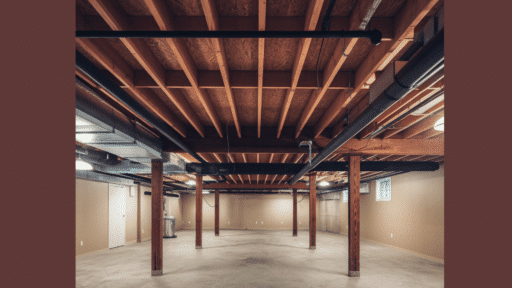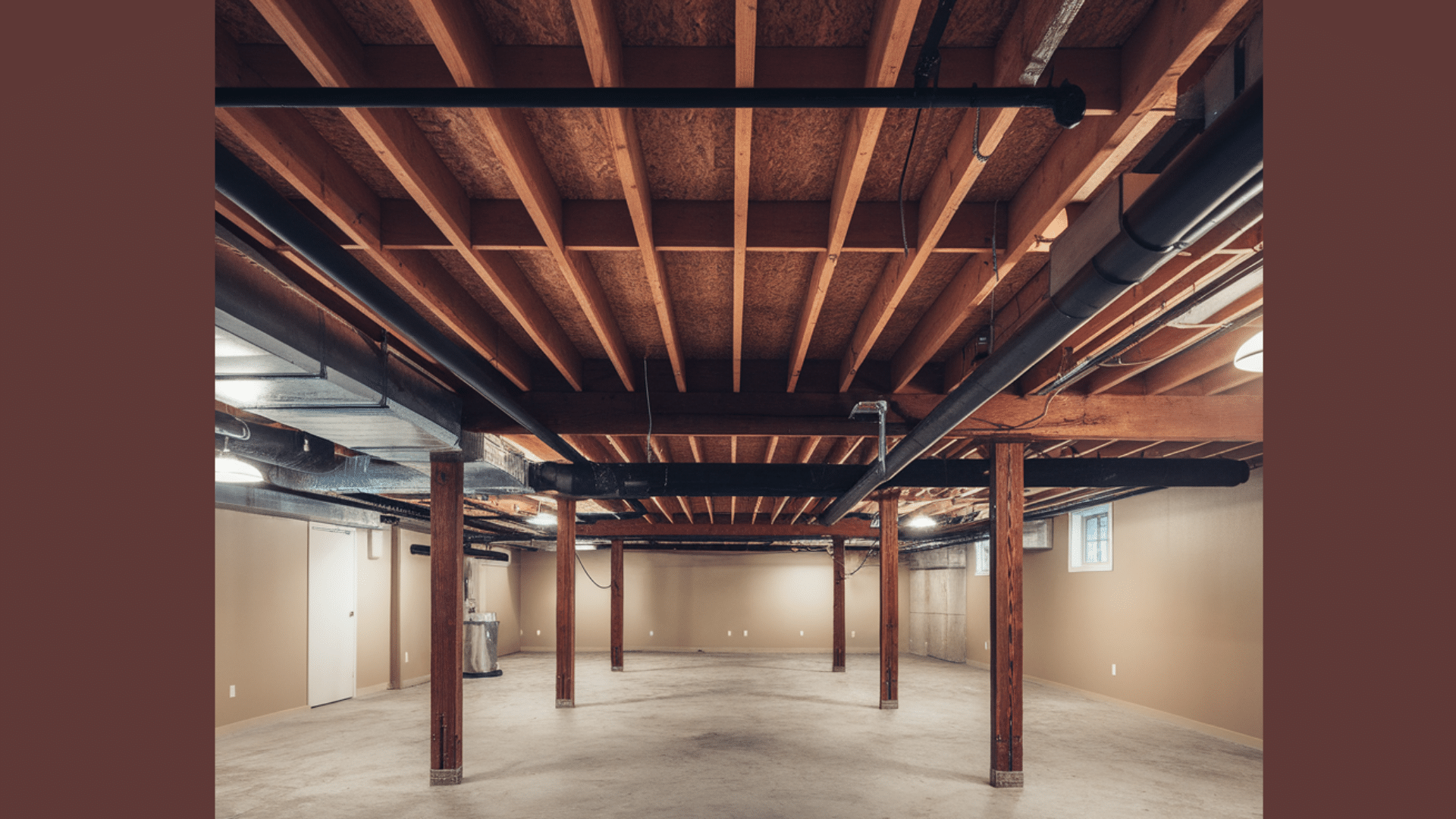More and more people are painting their basement ceilings black, and it’s catching on fast. Instead of trying to hide all the pipes and wires in their basements, they’re making them look cool by painting everything black.
It’s like giving your messy ceiling a fresh look without spending much money covering it up.
Black paint does two jobs at once: making the basement look nice and solving common problems. Think about it: those ugly pipes and spots you don’t like? The black paint helps them fade away.
Plus, it makes the basement feel put together, no matter what you use it for – watching movies, working out, or making art.
Sure, you must consider what paint to use and how to light the room properly, but many people find it worthwhile.
It’s a simple way to make your basement feel modern without breaking the bank on expensive ceiling work.
How to Paint an Exposed Basement Ceiling Black
Step 1: Prepare the Basement
- Start by removing any existing ceiling structure, like drop ceilings. This may involve cleaning up dust, patching walls, and managing cables.
- Use a vacuum to clear debris and ensure the area is clean and free of obstructions.
Step 2: Tape and Masking
- Use a laser level to mark the edges of the ceiling where the paint will stop. This ensures clean and straight lines.
- Tape off the walls and cover furniture, floors, and other areas with tarps to protect them from paint splatters. Proper masking prevents extra work later.
Step 3: Select the Right Paint and Tools
- Opt for matte black dryfall paint, ideal for exposed basement ceilings due to its ability to cover imperfections and create a clean finish.
- Invest in a sprayer, such as the Magnum X7, which is more efficient than brushes or rollers for painting ceilings with many pipes and ducts. Sprayers save time on uneven surfaces.
Step 4: Painting the Ceiling
- Begin spraying in small sections to get used to the sprayer and fine-tune your technique.
- Focus on even, light coats to minimize drips and ensure full coverage. Pay extra attention to corners and hard-to-reach areas.
- Lightly spray the top edges of walls for a seamless transition and to hide minor imperfections.
Step 5: Addressing Overspray and Touch-Ups
- If there are spots with excess paint or uneven coverage, use a roller to smooth them out.
- Inspect the ceiling after drying and apply touch-ups as needed. Matte black paint is forgiving, making it easier to correct errors.
Step 6: Post-Painting Cleanup
- Remove tarps carefully to avoid spreading any residual paint.
- Clean the sprayer and other tools thoroughly according to the manufacturer’s instructions to keep them in good condition.
- Dispose of paint cans and other materials responsibly.
Video Tutorial
For a complete walkthrough, watch this helpful video tutorial:
Pros and Cons of Painting an Exposed Basement Ceiling Black
Advantages:
1. Creates a modern appearance:
- Black paint transforms basic basement pipes and beams into an intentional design feature.
- Provides a finished, professional look without construction costs
2. Conceals structural elements:
- The dark color unifies pipes, wiring, and ducts into one cohesive surface
- Masks minor imperfections and inconsistencies in the ceiling
3. Improves spatial perception:
- Dark ceilings create an illusion of greater height
- Opens up typically confined basement spaces
Disadvantages:
1. Impacts lighting conditions:
- Dark ceilings absorb more light than lighter alternatives
- Often requires additional lighting fixtures for proper illumination
2. Limited color reversibility:
- Converting from black to lighter colors is challenging
- Multiple coats of primer needed for color changes
3. Maintenance requirements:
- Black surfaces show dust and cobwebs more prominently
- Regular cleaning is needed to maintain the appearance
- Touch-ups are required for any leaks or damage around pipes
Picking Colors for Your Basement Ceiling
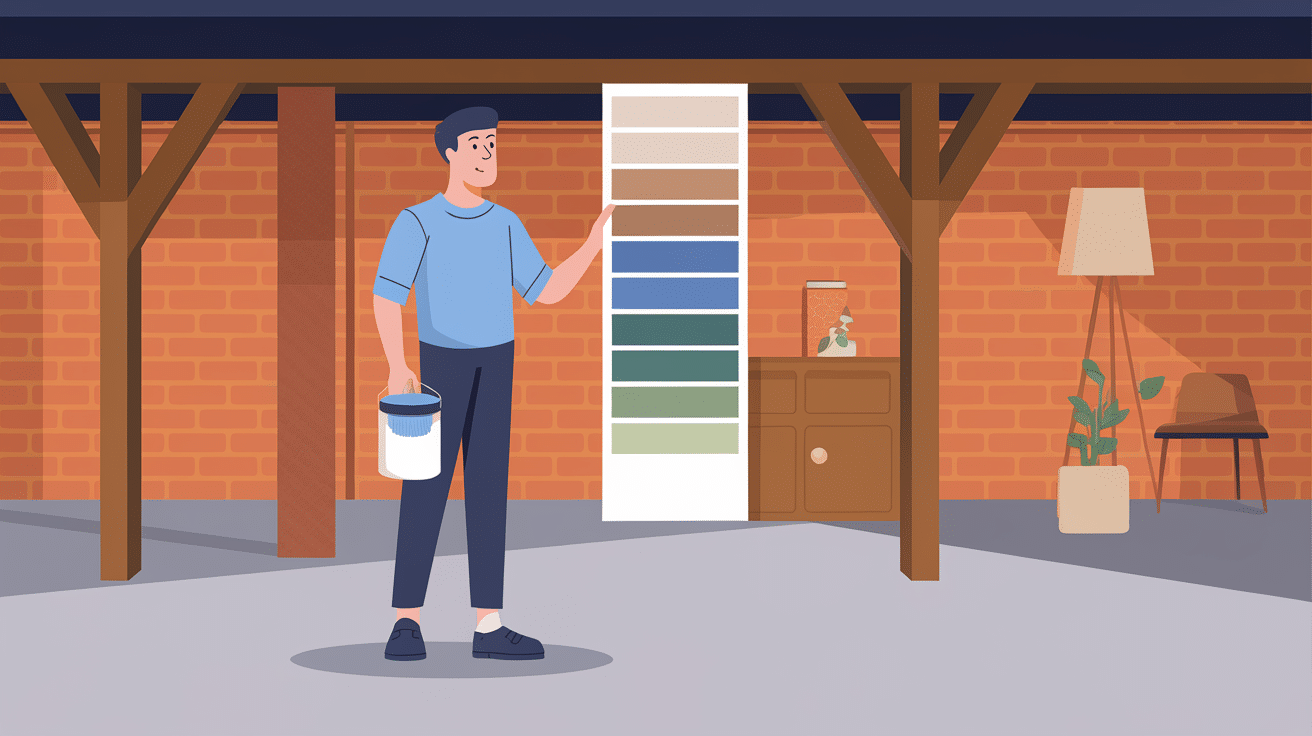
You have three main choices for basement ceilings: black, white, or other colors. Each one changes how your room feels and looks.
Black makes your ceiling feel far away, making your basement seem bigger. It also helps hide pipes and wires, making them blend. In-home theaters or gaming rooms, black works great because it cuts down on light reflection on screens.
White makes spaces feel bright and clean but shows every pipe and wire. It’s good for craft rooms or home offices where you need lots of light.
Other colors, like dark gray or navy blue, can work too. Gray gives you the benefits of black but feels softer. Blue can make your ceiling feel like the sky.
To make your black ceiling work better:
- Add bright lights
- Use light-colored walls
- Put in shiny or metallic decorations
- Pick furniture with light colors to balance the dark ceiling
Costs and Ways to Save Money When Painting Your Basement Ceiling:
Materials You’ll Need:
- Good black paint: $30-45 per gallon (you might need 2-3 gallons)
- Paint sprayer rental: $50-75 per day
- Drop cloths: $10-20
- Masks and safety gear: $25-40
- Cleaning supplies: $15-25
- Basic tools (brushes, rollers): $30-50
Doing It Yourself vs. Hiring Help:
- DIY total cost: $200-400 (includes all materials)
- Professional painting: $800-1,500 (depends on room size)
How It Compares to Other Options:
- Painting ceiling black: $200-1,500
- Adding drywall ceiling: $2,500-5,000
- Installing drop ceiling: $1,800-4,500
Ways to Save Money:
- Do the work yourself
- Look for paint sales at hardware stores
- Buy basic tools instead of fancy ones
- Rent equipment instead of buying
- Clean surfaces well to avoid needing extra paint
- Ask friends who’ve done it for leftover supplies
Smart Shopping Tips:
- Compare prices at different stores
- Buy sample sizes first to test the paint
- Get all supplies at once to save on trips
- Check if stores offer discounts for buying multiple items
Paint Types and Materials to Use For Your Basement Ceiling
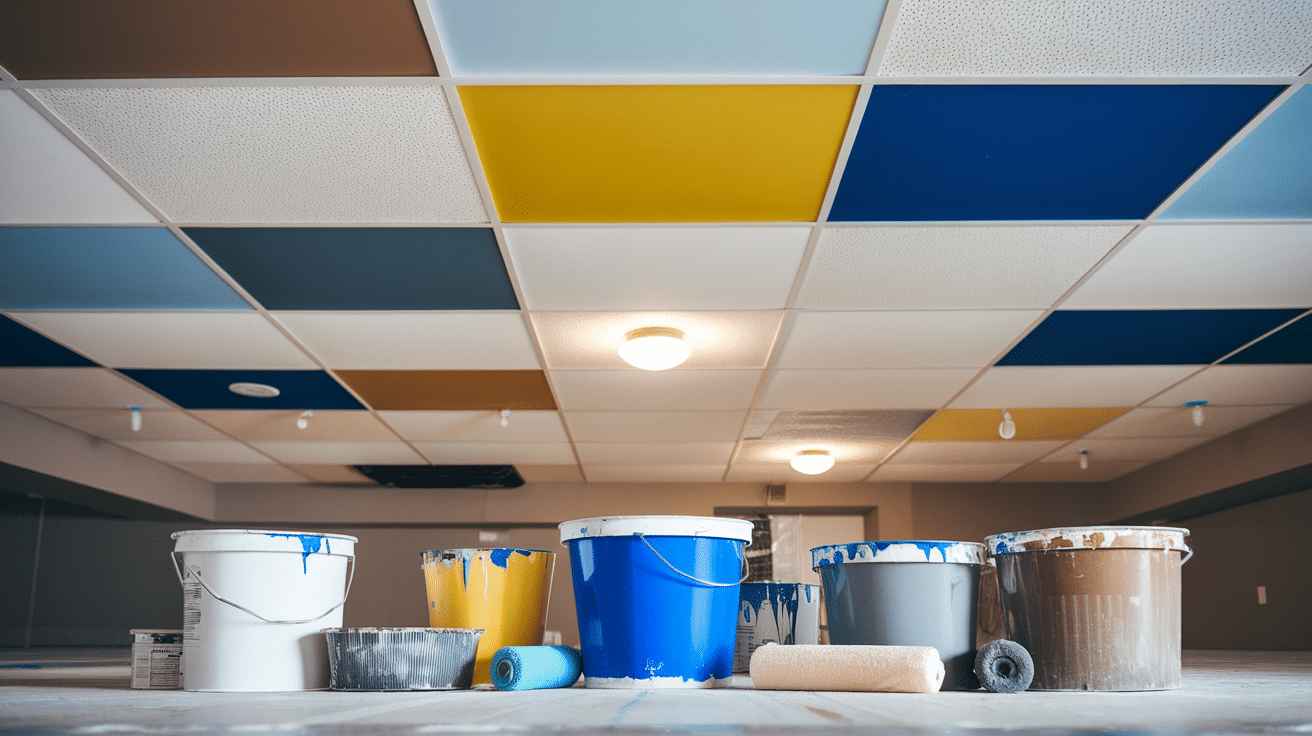
Paint Types You Should Use:
- Low-VOC paints keep the air clean while you work
- Black dry fall paint turns to powder before hitting the floor, making cleanup much easier
- Regular paint needs more cleanup time
Choosing How Shiny:
- Matte (not shiny) paint: Hides small bumps better
- Semi-gloss (a bit shiny) paint: Easier to clean but shows more bumps
Good Paint Brands to Try:
- Sherwin-Williams Pro Industrial
- Benjamin Moore Ceiling Paint
- Rust-Oleum Professional
- PPG Break-Through
Remember: Always get paint that’s made for use on metal pipes and different surfaces. Most brands have special ceiling paint that works well for basements.
How Black Ceilings Change Your Room’s Light?
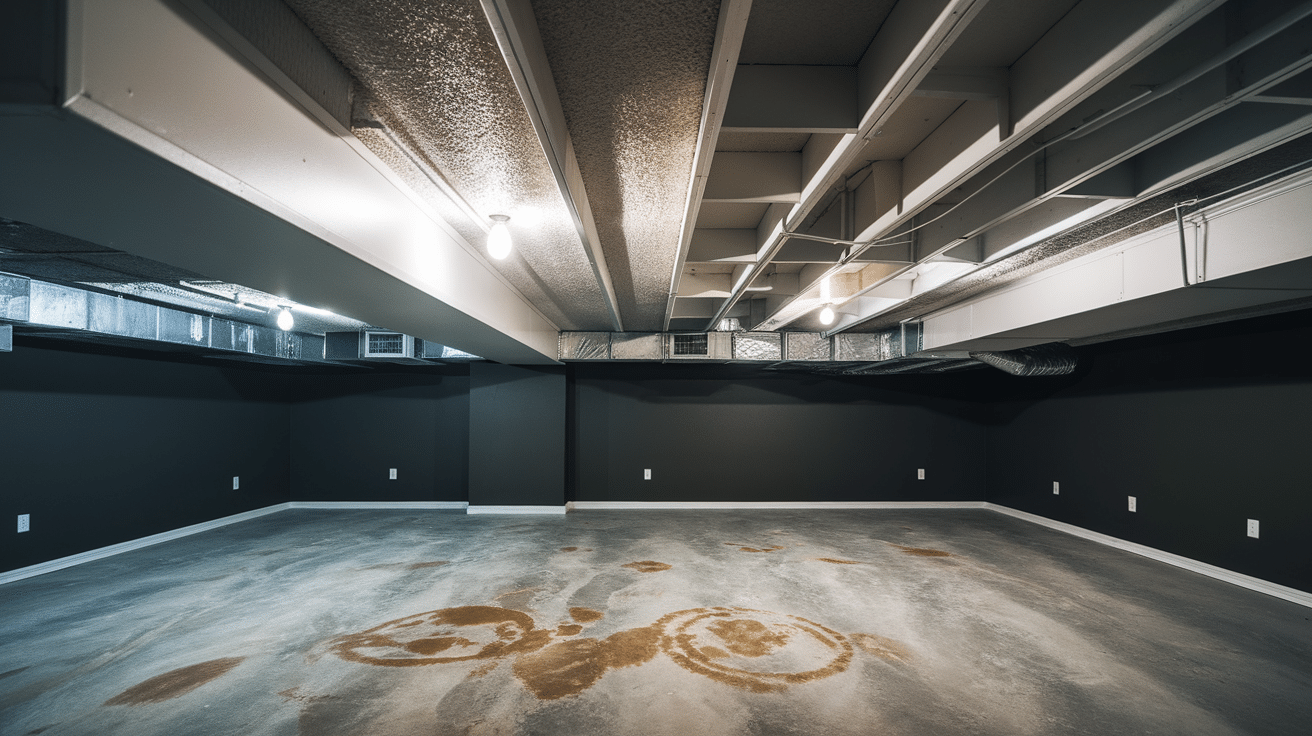
What Black Does to Light:
- It soaks up more light than light-colored ceilings
- It makes the room feel darker unless you plan ahead
- Can make small spaces feel bigger by hiding pipes
Making Your Room Bright Enough:
- Put in more light fixtures than you think you need
- Use bright LED bulbs that point in different directions
- Add wall lights and floor lamps, not just ceiling lights
- Place lights near walls to make them brighter
- Put shiny things like mirrors on walls
Alternatives to Painting an Exposed Basement Ceiling
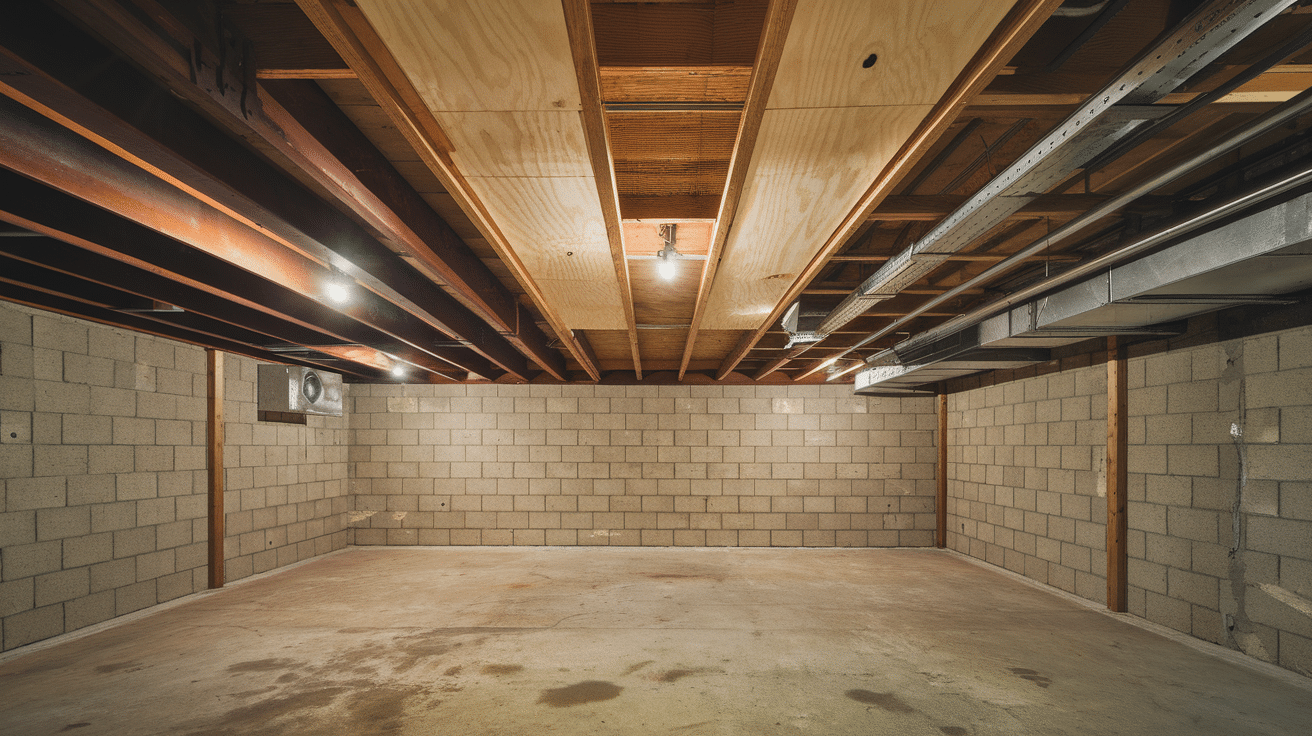
Putting Up a Drop Ceiling:
Good things about drop ceilings:
- It is easy to get to pipes and wires when you need to fix them
- It helps keep noise down between floors
- It comes in many nice-looking styles
- Can put lights inside it
Not-so-good things:
- It takes away some height from your room
- Costs more than painting (about $5-7 per square foot)
- I might need someone skilled to put it upright
Using Drywall:
Good things about drywall:
- It looks neat and clean, like your upstairs rooms
- It keeps heat in better
- It lasts a long time
Not-so-good things:
- It is hard to get to pipes and wires if they break
- It needs skilled workers to put up
- It can cost a lot (about $3-5 per square foot)
Fun Other Ideas:
- Put up wooden beams to make it look fancy
- Hang nice fabric to make it soft and pretty
- Use wood panels to make it look cozy
These are all good ways to make your basement ceiling look better without using paint. Each has good and not-so-good points, so pick the one that best suits your needs and money.
Expert Tips and User Advice
Tips From Home Fixers:
- Clean everything well before you start
- Please take pictures of where pipes and wires are before covering them
- Use good lights while working – the basement can be dark
- Do a small test area first
Things Not To Do:
- Don’t forget to wear safety glasses and a mask
- Don’t rush – take time to do it right
- Don’t skip cleaning to save time
- Don’t leave tools and wires where people can trip
Taking Care of Your New Ceiling:
- Check for water spots every few months
- Clean cobwebs with a soft brush
- Fix small problems right away
- Keep good airflow in your basement
Conclusion
Painting your basement ceiling black is a smart way to make your space look better without spending too much money.
It’s much cheaper than putting up a new ceiling, and you can do it yourself over a weekend. The black color hides pipes and wires well, making everything look neat and clean.
Before you start, clean everything well and get the right tools. Take your time to cover floors and walls so the paint doesn’t get where it shouldn’t.
While painting might initially seem scary, you can make your basement look great with good planning and care.
Remember, a black ceiling can work well if you add good lights and use light colors on your walls. Your basement can become a space you’ll love to use!
Frequently Asked Questions (FAQs)
Can I Paint My Basement Ceiling Black If It Has Exposed Ductwork?
Yes, painting around ductwork is common in exposed basement ceilings. Using a sprayer makes it easier to cover ducts evenly without missing spots.
What Is The Best Way To Clean A Painted Exposed Ceiling?
Use a soft brush or a vacuum with a brush attachment to gently clean dust and cobwebs from the painted surface. Avoid using water or harsh cleaners on the ceiling.
Do I Need To Turn Off My HVAC System While Painting?
It’s a good idea to turn off your HVAC system to prevent paint from circulating through the vents. Cover the vents with plastic sheeting for added protection.
How Do I Handle Areas With Wires Or Cables?
Make sure to secure wires and cables tightly before painting. Cover them with painter’s tape if you don’t want paint on them, or carefully spray around them.
Does Black Paint Hide All Imperfections In The Ceiling?
Black paint does a great job hiding flaws, like uneven surfaces or stains. However, very large cracks or damage might still need to be fixed before painting.

